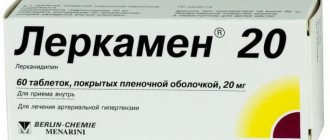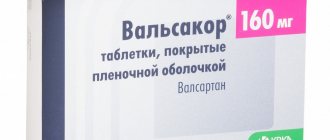Valsartan
Sodium deficiency in the body and/or decreased circulating blood volume (CBV)
In patients with severe sodium deficiency and/or reduced blood volume, for example, those receiving high doses of diuretics, in rare cases, arterial hypotension may occur at the beginning of treatment, accompanied by clinical manifestations. Before starting treatment with the drug, the sodium and/or BCC levels in the body should be corrected, including by reducing the dose of the diuretic.
If arterial hypotension develops, the patient should be laid down and legs elevated. If necessary, administer an intravenous infusion of 0.9% sodium chloride solution. After blood pressure has stabilized, treatment can be continued.
Hyperkalemia
When used concomitantly with dietary supplements containing potassium, potassium-sparing diuretics, potassium-containing salt substitutes, or with other drugs that can cause hyperkalemia (for example, heparin), caution should be exercised and regular monitoring of potassium levels in the blood should be performed.
Renal artery stenosis
The use of the drug in a short course in patients with renovascular hypertension, which developed secondary to unilateral renal artery stenosis, did not lead to any significant changes in renal hemodynamics, serum creatinine concentrations or blood urea nitrogen. However, given that other drugs that affect the RAAS may cause increases in serum urea and creatinine concentrations in patients with bilateral or unilateral renal artery stenosis, monitoring these parameters is recommended as a precaution.
Renal dysfunction
Patients with impaired renal function do not require dose adjustment of the drug. However, in cases of severe renal impairment (when creatinine clearance is less than 10 ml/min), caution is recommended. The simultaneous use of angiotensin II receptor antagonists, including valsartan, or ACE inhibitors with aliskiren should be avoided in patients with severely impaired renal function (creatinine clearance less than 30 ml/min).
Kidney transplant
There are no data on the safety of use in patients who have undergone kidney transplantation.
Liver dysfunction
In patients with liver failure, no dose adjustment is required, except in cases of cholestasis. The drug is excreted primarily unchanged in bile via the intestine, and drug clearance has been shown to be reduced in patients with biliary obstruction. When prescribing the drug to these patients, special care should be taken.
Quincke's edema
Angioedema, including the larynx and vocal folds leading to airway obstruction, and/or swelling of the face, lips, pharynx and/or swelling of the tongue, has occurred in patients receiving the drug, some of these patients have previously experienced angioedema due to taking other drugs, including ACE inhibitors. If angioedema develops, taking the drug should be immediately discontinued, and resumption of the drug is prohibited.
Primary hyperaldosteronism
The drug is ineffective for the treatment of arterial hypertension in patients with primary hyperaldosteronism, since activation of the RAAS is not observed in this category of patients.
CHF/period after myocardial infarction
In patients with CHF or after myocardial infarction who begin treatment, there is often a slight decrease in blood pressure, and therefore it is recommended to monitor blood pressure at the beginning of therapy. Provided that the dosage recommendations are followed, there is usually no need to discontinue the drug due to arterial hypotension. Evaluation of patients with CHF should include assessment of renal function.
Due to inhibition of the RAAS, renal dysfunction may occur in some patients. In patients with CHF II-IV functional class according to the NYHA classification, treatment with ACE inhibitors and angiotensin II receptor antagonists may be accompanied by oliguria and/or an increase in azotemia and (rarely) acute renal failure and/or death. Therefore, in these categories of patients, before using the drug, as well as periodically during drug therapy, it is necessary to evaluate renal function.
Combination therapy for arterial hypertension
For arterial hypertension, the drug can be used in monotherapy, as well as simultaneously with other antihypertensive drugs.
Combination therapy in the period after myocardial infarction
It can be used in combination with other drugs used after myocardial infarction, namely: thrombolytics, acetylsalicylic acid as an antiplatelet agent, beta-blockers and HMG-CoA reductase inhibitors (statins).
In this category of patients, it is not recommended to use concomitantly with ACE inhibitors, since this combination therapy does not have advantages over monotherapy with the drug or ACE inhibitor in terms of overall mortality from any cause.
Combination therapy for CHF
For CHF, the drug can be used both in monotherapy and simultaneously with other drugs - diuretics, cardiac glycosides, as well as ACE inhibitors or beta-blockers. In this category of patients, the use of triple combination therapy with ACE inhibitors, a beta-blocker and Valsartan is not recommended.
Use with caution in patients driving vehicles and engaging in activities that require increased attention and speed of motor and mental reactions (risk of dizziness or fainting).
Patient reviews
- Raisa, 53 years old. I have been suffering from hypertension for a long time. And periodically, addiction to all medications occurs, which is why they have to be changed. I’ve been using Valsartan for six months now, my blood pressure remains between one hundred and thirty to one hundred and forty, I feel good, and there are practically no headaches.
- Lyudmila, 47 years old. Due to the fact that the disease (stage 3 hypertension) began to gradually progress, the attending physician said that it was necessary to intensify therapy, and Valsartan alone was no longer enough. She prescribed me Valz N because it contains two drugs at once. The transition went smoothly, I felt better on Valse and my blood pressure stopped jumping.
The effect of the drug on blood pressure - increases or decreases
The drug Valsartan belongs to the pharmacological group of angiotensin 2 receptor antagonists. It is characterized by the presence of pronounced antihypertensive properties that help lower blood pressure and relax blood vessels. At the same time, the effect of Valsartan tablets does not affect the pulse rate, which is one of the key advantages of this drug.
The therapeutic effect is achieved due to the ability of the active ingredients of the drug to stimulate the processes of aldosterone production, providing a vasoconstrictor effect, which leads to a decrease in blood pressure.
The drug begins to act 2 hours after using the tablets. After 4 hours, blood pressure levels return to the age norm. The hypotensive effect lasts throughout the day.
Valsartan does not cause withdrawal symptoms. However, upon unauthorized cessation of treatment, swelling, increased blood pressure and other symptoms characteristic of hypertension reappear. Therefore, the optimal duration of the therapeutic course should be determined by the attending physician on an individual basis.
The maximum effect is achieved after 3-4 weeks of using blood pressure tablets. When used correctly, this remedy allows you to get rid of cardiovascular pathologies, prevent the progression of the pathological process and the occurrence of associated complications.
Antihypertensive drug Valsartan
Pregnancy and lactation
The blood pressure drug Valsartan is strictly not recommended for the treatment of patients expecting the birth of a baby. The use of this drug during the 2nd and 3rd trimester of pregnancy can lead to the following adverse effects for the child:
- Kidney failure;
- Hyperkalemia;
- Arterial hypotension (excessively low blood pressure);
- Slowing down the process of ossification of the fetal skull bones.
The use of the drug Valsartan during lactation is also not recommended, due to the lack of sufficient information about the ability of the active ingredients of the drug to penetrate into breast milk and their effect on the baby’s body. For this reason, it is recommended that a nursing mother choose a safer and milder anti-pressure remedy, so as not to risk the health of her child.
The drug is contraindicated in pregnant women
Prices for the drug and its analogues
The cost of Valsartan substitutes directly depends on the country of origin. Russian-made drugs are cheaper than their foreign counterparts. List of prices for Valsartan analogs and substitutes:
| Name of the medicine | Dosage in mg | Number of pieces per package | Average price in rubles |
| Valsartan | 160 | 30 | 162-183 |
| Valaar | 80 | 28 | 192-201 |
| Amlodipine+Valsartan | 16/12,5 | 30 | 228-230 |
| Duopress | 160/12,5 | 30 | 266-274 |
| Vazar | 160 | 30 | 360-490 |
| Walzap | 80 | 30 | 310-390 |
| Valesa | 80 | 30 | 370-380 |
| Lozap | 50 | 30 | 380-410 |
| Valsa | 80 | 28 | 273-280 |
| Candecor | 80 | 28 | 620-636 |
| Angizar | 50 | 30 | 180-220 |
Composition, release form and dosage
The blood pressure medicine Valsartan is presented on the pharmaceutical market in tablet form. The main active substance is Valsartan. Available in dosages of 80 mg and 160 mg.
The composition of Valsartan tablets also includes the following auxiliary components:
- Magnesium stearate;
- Croscarmellose sodium;
- Aerosil;
- Microcrystalline cellulose.
Valsartan is sold in packages of 7, 10, 14, 20, 30, 60 tablets.
Amlodipine or valsartan - what to choose
To enhance the therapeutic effect, the active substance valsartan in some substitutes is combined with substances from another pharmacotherapeutic group that is compatible with angiotensin II receptor antagonists. Substances from the CCB group - amlodipine, nifedipine, verapamil - have good compatibility with valsartan.
The Hungarian company Gedeon Richter produces the combination drug Amlodipine-Valsartan in different dosages:
- 5 mg + 80 mg – light beige round pills with engraved CI3 markings;
- 5 mg + 160 mg – pink capsules marked CI4;
- 10 MG + 160 MG – light beige capsule tablets marked CI
The indication for use of the drug is arterial hypertension, which requires intensive therapy. Some sources call Amlodipine an analogue of Valsartan, but this is a gross mistake, since the substance amlodipine belongs to a completely different pharmacological group.
Prices for Amlodipine-Valsartan range from 200 rubles.
Table - existing forms of the drug Amlodipine with prices *
| Name | Manufacturer | Active substance | Price |
| AMLODIPINE ALKALOID 0.005 N30 TABLE | Alkaloid AO | Amlodipine | 80.70 RUR |
| AMLODIPINE 0.005 N60 TABLE | Vertex Joint Stock Company | Amlodipine | 109.60 RUR |
| AMLODIPINE SANDOZ 0.005 N30 TABLE | Lek D.D. | Amlodipine | 152.80 RUR |
| AMLODIPINE 0.005 N30 TABLE /PHARMAKOR PRODUCTION/ | PHARMACOR PRODUCTION LLC | Amlodipine | 94.20 RUR |
| AMLODIPINE 0.005 N30 TABLE /AKRIKHIN-UNIQUEM/ | Uniquem Laboratories Limited | Amlodipine | 85.50 RUR |
| AMLODIPINE 0.01 N20 TABLE | OZONE, LLC | Amlodipine | 53.20 RUR |
| AMLODIPINE 0.01 N30 TABLE /ROZLEX PHARM/ | ROZLEX PHARM LLC | Amlodipine | 23.00 RUR |
| AMLODIPINE-PRANA 0.01 N90 TABLE /PRANAFARM/ | Pranapharm, LLC | Amlodipine | 60.40 RUR |
| AMLODIPINE-ALSI 0.005 N30 TABLE | Alsi Pharma, JSC | Amlodipine | 44.60 RUR |
| AMLODIPINE-TEVA 0.01 N30 TABLE | Teva, LLC | Amlodipine | 155.90 RUR |
| AMLODIPINE-PRANA 0.005 N90 TABLE /PRANAFARM/ | Pranapharm, LLC | Amlodipine | 48.60 RUR |
| AMLODIPINE-VERO 0.005 N30 TABLE | Veropharm, JSC | Amlodipine | 42.20 RUR |
| AMLODIPINE-VERO 0.01 N30 TABLE | Veropharm, JSC | Amlodipine | 62.10 RUR |
| AMLODIPINE-BORIMED 0.01 N30 TABLE | Borisov Medical Preparations Plant, JSC | Amlodipine | 30.40 RUR |
| AMLODIPINE-ALSI 0.01 N30 TABLE | Alsi Pharma, JSC | Amlodipine | 64.90 RUR |
| AMLODIPINE-BIOKOM 0.01 N30 TABLE | Biocom, JSC | Amlodipine | 46.40 RUR |
| AMLODIPINE-PRANA 0.005 N30 TABLE /PRANAFARM/ | Pranapharm, LLC | Amlodipine | 29.20 RUR |
| AMLODIPINE-PRANA 0.01 N30 TABLE /PRANAFARM/ | Pranapharm, LLC | Amlodipine | 39.20 RUR |
| AMLODIPINE-TEVA 0.005 N30 TABLE | Teva, LLC | Amlodipine | 102.50 RUR |
| AMLODIPINE-BIOKOM 0.005 N30 TABLE | Biocom, JSC | Amlodipine | 31.90 RUR |
| AMLODIPINE 0.01 N20 TABLE /CHEMOPHARM/ | Hemofarm d.o.o./Hemofarm A.D. | Amlodipine | 168.90 RUR |
| AMLODIPINE 0.01 N60 TABLE | Vertex Joint Stock Company | Amlodipine | 156.60 RUR |
| AMLODIPINE 0.01 N50 TABLE /MEDISORB/ | Medisorb, JSC | Amlodipine | 89.30 RUR |
| AMLODIPINE 0.01 N90 TABLE | OZONE, LLC | Amlodipine | 103.50 RUR |
| AMLODIPINE SANDOS 0.01 N30 TABLE | Lek D.D. | Amlodipine | 253.90 RUR |
| AMLODIPINE 0.01 N30 TABLE /AKRIKHIN-UNIQUEM/ | Uniquem Laboratories Limited | Amlodipine | 97.40 RUR |
| AMLODIPINE ALKALOID 0.01 N30 TABLE | Alkaloid AO | Amlodipine | 107.80 RUR |
| AMLODIPINE 0.005 N90 TABLE | OZONE, LLC | Amlodipine | 87.10 RUR |
| AMLODIPINE 0.005 N20 TABLE | Vertex Joint Stock Company | Amlodipine | 55.60 RUR |
| AMLODIPINE 0.01 N30 TABLE | OZONE, LLC | Amlodipine | 28.40 RUR |
| AMLODIPINE 0.005 N20 TABLE /CHEMOPHARM/ | Hemofarm d.o.o./Hemofarm A.D. | Amlodipine | 111.60 RUR |
The active ingredients of combination medications have complementary mechanisms of action that can effectively lower blood pressure.
Side effects
Valsartan blood pressure pills can cause the following unwanted reactions:
- Cough syndrome;
- Hair loss;
- Impaired renal function;
- Pharyngitis;
- Fainting conditions,
- Painful sensations localized in the abdominal area;
- Increased fatigue, loss of strength;
- Arthritis;
- Headaches and attacks of dizziness;
- Kidney failure;
- Low blood pressure readings;
- Dyspepsia;
- Hepatitis;
- Hyperkalemia.
In rare cases, viral infections and inflammatory processes affecting blood vessels may develop.
Headache is a possible side effect
Contraindications to taking the medicine
The high blood pressure medication Valsartan has the following clinical contraindications:
- Chronic form of alcoholism;
- Increased tendency to allergic reactions;
- Age category of the patient, under 6 years;
- Individual intolerance and hypersensitivity to the active components of the medication;
- Diabetes;
- Severe renal dysfunction;
- Double stenosis of the renal arteries;
- Severe form of liver dysfunction;
- Cholestasis.
During treatment with Valsartan, drinking large amounts of liquid is contraindicated!
Instructions for use of the drug
Instructions for use Valsartan recommends taking tablets 30 minutes before a meal or 2 hours after a meal. The dosage and regimen of the drug depends on the patient’s diagnosis and other features of the specific clinical case.
Hypertension
The use of Valsartan tablets for the treatment of hypertension involves the use of medication in a dosage of 80 mg throughout the day. If it is not possible to stabilize blood pressure, the daily dose can be increased to 160 mg or 320 mg. To achieve the most pronounced hypotensive effect, this drug is recommended to be taken in combination with diuretics.
Heart attack
Treatment with Valsartan begins 12 hours after the end of the heart attack. Initially, patients are given 20 mg of the drug 2 times a day, gradually increasing the daily dosage of the drug to 320 mg. The optimal duration of the therapeutic course is 2-3 weeks.
Valsartan is prescribed after a heart attack
Heart failure
Congestive heart failure is a clinical indication for the use of Valsartan. Therapy begins with a daily dosage of 40 mg. Gradually, the dose of the medicine is increased to 160 mg throughout the day (this amount must be divided into 2 doses). The treatment regimen and course duration for heart failure are determined by a cardiologist exclusively on an individual basis.





